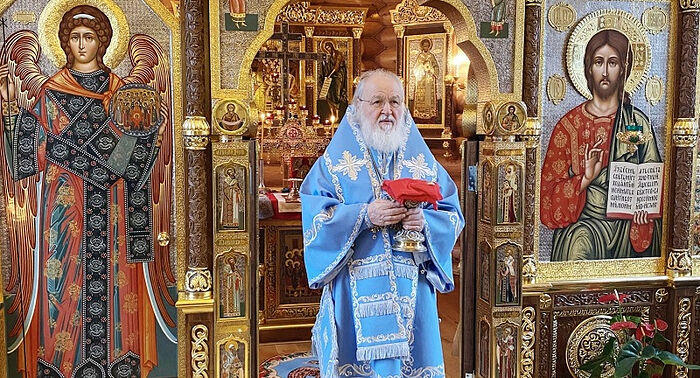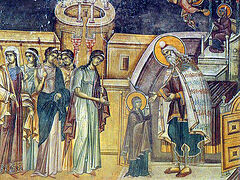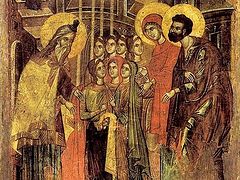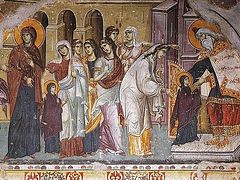In the name of the Father, and the Son, and the Holy Spirit!
Today we celebrate one of the great twelve feasts, the Entrance of the Most Holy Theotokos into the Temple. From Church Tradition we know the story of how the Virgin Mary’s pious parents brought into the temple the young maiden, perhaps even still an infant—we don’t know her exact age at the time, except that she was in early childhood—so that she would remain there in the temple to live, study, and spiritually grow. This was a pious tradition. Probably it was not always carried out, but the fact itself of dedicating a child to God was part of the religious tradition of Israel. This usually took place with the firstborn male, but in this case a girl was dedicated to serving the Lord—the child Mary, born to the pious family of Joachim and Anna.
Of course, the sanctification of an infant to God, the bringing of the child into the temple, had a very great spiritual significance; after all, in the Jerusalem temple was once kept a great holy shrine—the Ark of the Covenant, which at God’s command was prepared by the Jews who departed from Egyptian captivity. In the ark was kept the very great divine gift—the Tablets of the Covenant, those very same stone tablets that Moses received on Mt. Sinai when he met God. Then the Lord gave him the great moral law, which was not only etched in people’s hearts—and that is precisely how God created them—but also written by God’s will in the form of concrete instructions. Ancient Israel preserved this great holy shrine as testimony to the fact that the words inscribed in the covenant are not human words, that they do not proceed from human wisdom, but that this is the authentic word of God, this is the will of God, this is divine law. In the ark besides the tablets was a jar of manna—the very food that was given in a miraculous manner from heaven to the ancient Israelites as they departed by God’s will from Egyptian captivity and wandered forty years in the Sinai desert. Manna, which miraculously came down from heaven, preserved people’s lives, and they survived in the difficult conditions of the desert by eating it. It was truly a very great and holy thing given to people by God.
Therefore, no one could enter into the Holy of Holies, the furthermost part of the temple, which can be compared to our altars in Christian churches—only the high priest, who entered this place in order to perform a special censing once a year. Nevertheless, when the high priest met the child Mary on the steps of the temple, as Church Tradition tells us, he led her not only into the temple, but also into the Holy of Holies, although this was categorically forbidden and contradicted all the laws that the Israelite people observed. And we believe that that is how it was, because the Entrance into the temple of the Most Holy Theotokos became an act filled with enormous spiritual power and great symbolic meaning. The Virgin Mary entered into the Old Testament temple and received the grace of God, in order to begin her life’s path that led to her birth of the Messiah, Lord and Savior, to her contemplation of His terrible sufferings, and finally, to her eternal heavenly glory.
The celebration of the Entrance into the Temple of the Most Holy Theotokos also helps us, separated from that event by millennia, to understand what enormous significance the temple had in the life of the Jewish people for the preservation of the true faith. But in our times the churches preserve the same significance, and this is not at all accidental. First of all, in the Orthodox Church, just as in the ancient Jerusalem temple, there are particularly sacred things. On the throne, which is the central place in the church, are kept antimensions—a cloth with the relics of God-pleasers. Similar to how in the ancient Church the Holy Eucharist was celebrated in the catacombs on the graves of the martyrs, so do we serve the Divine Liturgy on the relics of saints sewn into the antimensions.
The church is filled with great grace when the Divine Eucharist is served, and this grace unites with material objects, first of all with the holy icons. This is why, when we venerate the icons we venerate not boards, not paint, but the material bearers of divine grace, partaking of divine power and divine energy. This is what it means to venerate the holy icons, and I will repeat: We venerate not the board, not the paint, not the beauty produced by human hands, but the visible bearers of divine grace.
First of all, the bearers of divine grace are people who received this gift at Baptism and in Communion of the Holy Mysteries of Christ. But we know how often sin tears grace from our souls, and we become like the barren fig tree. Inanimate objects can also be bearers of divine grace—first are the holy icons, which we honor, and by kissing them we acquire a piece of the grace that rests on the holy images.
Today’s feast teaches us very much. It turns our attention to the pious custom that the Israelite people had of bringing children to the temple. This is a reminder to all parents, especially to those who have baptized their children. You must bring them to church; this is the direct responsibility of every parent. Why bring your children to church? So that the child will receive that piece of divine energy, so that divine light would touch his nature, his mind, memory, will, and his senses. So that as your child walks the path of life, he would rely not only his own poor strength, which so easily falls apart under the impact of bad external influences, but so that the child would have an inner spiritual core, and the power of divine grace would help him resist sin, growing in wisdom, purity, and spiritual and physical strength.
Today’s feast reminds us of the special significance of the church also as a school of piety. After all, in the ancient Jerusalem temple people not only prayed—many lived at the temple and, of course, studied. It was to this abiding in the temple that the Virgin Mary’s parents gave their miraculously born infant—so that she would grow there from strength to strength in prayer and study. And we know to what this abiding in the temple of the Virgin Mary led—to the great event of the Annunciation, which became the harbinger of her giving birth to the Savior of the world.
A temple is undoubtedly a school of piety—there we hear remarkable prayerful texts, and even if we do not completely understand them, we are permeated with their spiritual meaning; because prayer in church especially influences a person’s mind and heart. We also learn in church through hearing the world of God, through sermons; but most importantly, we receive in church a particular gift of grace, without which it is hard to go through life.
Therefore, the event of the Entrance into the Temple of the Most Holy Theotokos should not only teach parents about the necessity of bringing their children to church, so that they would be happy in life, so that they would be able to walk their life’s path. This is a reminder to the parents themselves, and to all people of how important it is to go to God’s church, where our weak forces, both spiritual and physical, would be filled with divine energy, divine strength. And as proof of these words I would like to cite the example of the martyrs and confessors who only recently died for the sake of Christ in our lands. Where did such strength in our people come from? Where did they get the ability to overcome extremely difficult trials and persecutions? From that very grace in which the people were brough up, which they acquired in the multitude of churches in the Russian lands. And if it weren’t for that remarkable generation of Orthodox people, who in those very churches tempered their spirit, then the Orthodox faith, having undergone terrible persecutions and the extermination of the faith, would hardly have been preserved in our land to the twenty-first century.
Our historical path, our historical experience is among other things testimony to the power of God’s grace, which through prayer, through going to church, through receiving the Holy Mysteries of Christ strengthens our minds, our will, and our feelings and makes us capable of acquiring salvation. Salvation, which through the entrance of the child Mary into the Jerusalem temple, through the suffering and Resurrection of the Savior, through the descent of the Holy Spirit upon the Apostles and through them upon the whole Church, is given also to us, so that despite our human weakness we would have hope in eternal life. Amen.





